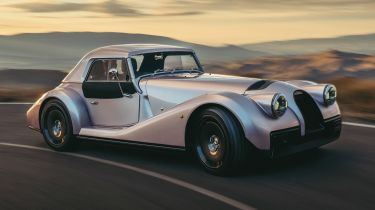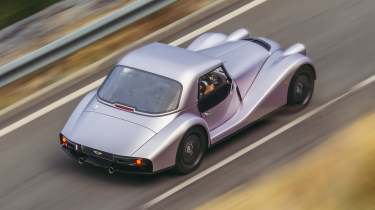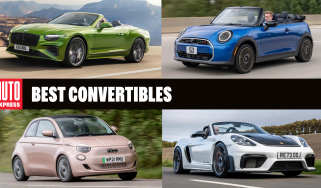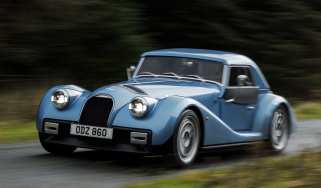Morgan Supersport review
The Supersport takes the mantle of the most usable Morgan to date, yet comprehensive revisions have also made it the best to drive
Our opinion on the Morgan Supersport
For a Morgan, the Supersport has been restyled and reworked in a big way. Thankfully the characteristics you expect of a Morgan are alive and well - perhaps even more evident than ever before. The engine is still a peach and suits the Supersport brilliantly, the handling more focused than the old Plus Six, but the ride is agreeable and those couple of new practical touches are greatly appreciated. The Supersport might not have the everyday usability of other sports cars, though you could argue that simply makes it feel all the more special when the mood strikes to take it out.
| Key specs | |
| Fuel type | Petrol |
| Body style | Roadster |
| Powertrain | 3.0-litre twin-turbo 6cyl |
| Safety | N/A |
| Warranty | Three years/36,000 miles |
About the Morgan Supersport
It might not look like it at first glance, but the Supersport is an all-new model from Morgan designed to replace the Plus Six as the firm’s flagship model. Sitting above the Plus Four (and below the limited-run, sold-out Midsummer), the Supersport retains much of the same design and hardware as the Plus Six, although it’s been revamped thoroughly enough to earn that new name, according to the company.
Getting into a Supersport costs £102,000 - making it even more expensive than the final iteration of the Plus Six, the £96,995 ‘Pinnacle’. That price doesn’t include the £2,000 soft-top or £3,000 hard-top, either. It’s somewhat difficult to pigeon-hole Morgan’s new car against competition, though its price tag does put it into the firing line of some tasty opposition like a base-level Porsche 911 or a well optioned Lotus Emira.
Used - available now

2023 Vauxhall
Corsa
22,623 milesManualPetrol1.2L
Cash £13,697
2018 Mercedes
A-Class
45,973 milesManualPetrol1.6L
Cash £13,097
2022 DS
DS 3 CROSSBACK E-TENSE
14,736 milesAutomaticElectric
Cash £12,697
2021 Volkswagen
Polo
42,146 milesManualPetrol1.0L
Cash £12,197There are no trim levels to choose from with the Supersport, nor is there any choice of powertrain yet. Carried over from the Plus Six is the familiar ‘B58’ twin-turbocharged, three-litre straight-six from BMW. Power is unchanged from the old car with 335bhp being sent to the rear wheels via a ZF eight-speed automatic transmission. There’s no manual option, although the BMW Z4 Handschalter has proved the engine could work with one.
Underneath, however, the Supersport’s platform carries a new ‘CVX’ designation, rather than the ‘CX’ of the Plus Six. Loads of suspension and chassis tweaks aim to make the Supersport more of a contemporary driver’s car, while adjustments to the interior have been made in the hope of this being the most usable, modern car in Morgan’s 116-year history.
Performance & driving experience

| Pros |
|
| Cons |
|
The excellent Plus Four and Plus Six showed us that Morgans could provide both a charmingly quaint and relaxed driving experience, yet also give you the performance expected of a contemporary sports car, not to mention the inherently engaging driving dynamics that come with Morgans. In the case of the new Supersport, it was designed from the outset to be the best-driving Morgan to date.
For starters there’s the new featherweight aluminium CXV platform. The Morgan Supersport might be 95kg heavier than the Plus Six at 1,170kg, but it’s certainly in the same realm as the 1,102kg Alpine A110, rather than the likes of the Porsche 911 and BMW M4, both of which weigh several hundred kilos more. It’s not just the low weight that the Supersport has on its side, because the BMW’s twin-turbocharged, three-litre straight-six has been retained from the Plus Six, as has its output of 335bhp and 500Nm of torque. As evidenced by the obviously BMW-derived gear lever, there’s an eight-speed ZF automatic gearbox in the Morgan sending its power to the rear wheels - and through the £2,340 mechanical limited-slip differential on our test car. If you specify the £3,000 ‘Dynamic Handling Pack’, you also get Nitron adjustable dampers front and rear with a bespoke set-up for the Supersport. Anyone with particularly slender arms can tweak the damping on the fly without having to take off a wheel, as Morgan suggests.
Categorising the Supersport as a hefty facelift of the Plus Six wouldn’t be right because the Supersport’s chassis revisions are rather significant. The equally lovely standard 18-inch ‘Superlite’ wheels or optional 19-inch ‘Aerolite’ items are made from forged aluminium and represent up to 4.1kg of weight shaved off each corner. Morgan went to 10 different companies to supply the rubber, eventually ending up with Michelin Pilot Sport 5 tyres with a slightly taller sidewall than the old Plus Six to help give some more compliance over rough roads. In addition, there’s also a 10mm wider track on both sides, firmer suspension bushes, a double-wishbone set-up front and rear, extra underbody bracing, and stiffer coil springs with the positioning of the struts changed to counter the bump steer occasionally found in the old Plus Six. The Supersport is 10 per cent stiffer overall than the Plus Six too, with the carbon-fibre hard-top (the only bit of carbon found on the car) contributing a further 10 per cent to torsional stiffness.
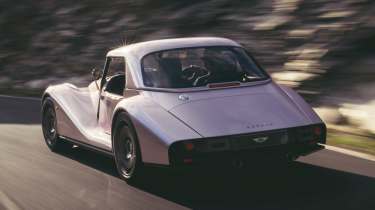
Despite the 19-inch wheels not leaving much of a gap in those gloriously sweeping wheelarches and the car’s increased stiffness, the Supersport is surprisingly composed over ruts and bumps. It’s not quite up there with properly modern sports car for day-to-day comfort, but mid-corner brittleness that you may find in a Plus Four isn’t as apparent in the Supersport. From our experience the 18-inch wheels are noticeably squidgier and would be our preferred choice on British roads.
In the bends the Supersport really delivers. Morgan has removed one of the universal joints from the steering for less friction in the hope of providing a more precise feel - and it works. Turn into a corner and the front end immediately responds, and with the headlights and wheelarches always in view, you can position the Supersport extremely well - like any Morgan before it. Given the Supersport’s communicative steering, you might be inclined to chuck it into corners and lean on the generous amount of grip equally afforded by the wide tyres and lack of weight. For us, the Supersport does its best work when you’re gentle on turn-in with a subsequent boot of the throttle to overload the rear; having those rear wheels literally within arm’s reach means the Supersport telegraphs any loss of grip incredibly well too.
The braking set-up is no different to the Plus Six’s and is strong enough to rein in the Supersport - although some might find the pedal a little too stiff at low speeds. We also found no issue of overheating after a few hours of hard use on miles of hairpin-punctuated roads.
Performance, 0-60mph acceleration and top speed

The Morgan’s 3.0-litre straight-six might be less powerful than a Porsche 911’s standard 389bhp or a 400bhp V6-powered Lotus Emira, but with significantly less weight to move around, the Supersport can accelerate from zero to 62mph in 3.9 seconds (0.3 seconds quicker than the Plus Six) and on to a top speed of 166mph.
In a straight line, the Supersport’s punch belies its classic looks. There’s a healthy wave of torque with the maximum coming in from just 1,250rpm, although it also feels rewarding to rev the engine up to its 6,500rpm limit. Flick between Normal, Sport and Sport+ drive modes and you’ll experience a distinct change in responsiveness from the eight-speed auto, too.
There’s a little more rumble to the Supersport than in other models that use this engine, such as the Toyota Supra and BMW Z4. That can be attributed to our car’s optional £3,000 active sports exhaust (a bespoke item from UK manufacturer Burchills), which can be specified in black or silver. We’d definitely recommend going for this option, however, because with the roof down the buffeting (thanks to the low-rise windscreen) would make it difficult to hear the exhaust even in Sport and Sport+ modes - which would be a shame.
| Power | 0-62mph | Top speed |
| 335bhp | 3.9 seconds | 166mph |
| 335bhp | 3.9 seconds | 166mph |
"As its looks suggest, the Morgan Supersport gives you almost a completely different experience to contemporary sports cars. It might have some serious performance, but it’s more grown up and usable than any Morgan before. It’s a great mix of old and new technology and you can rest assured every trip in the Supersport will feel like an event.” - Alastair Crooks, Senior News Reporter. Tested the Morgan Supersport in Spain.
MPG & running costs

| Pros |
|
| Cons |
|
Although the Supersport is definitely not designed for efficiency with its upright windscreen, the car’s low weight and eight-speed automatic, with its ability to keep revs low in ‘Normal’ mode, help contribute to a claimed efficiency figure of 36.8mpg (1.4mpg worse than the Plus Six). That figure is equal parts impressive and laughable, because we found during our test that if you tap into the twin-turbocharged straight-six’s full power even occasionally, you’ll see average economy in the mid-20s – if you’re lucky. On the other hand, CO2 emissions are actually better in the Supersport than its predecessor at a reasonable 175g/km.
With a limited annual production capacity of around 850 cars, Morgans retain their value exceptionally well and owners of the Plus Six could enjoy it holding on to 66 per cent of its value after three years and 60,000 miles. It’s too early to tell how strong the residuals for the Supersport will be, but we suspect a similar if not better performance. Morgan offers an industry-standard warranty of three years and 36,000 miles, which can be extended to four years and 48,000 miles.
| Model | MPG | CO2 |
| Morgan Supersport | 36.8mph | 175g/km |
Interior, design & technology
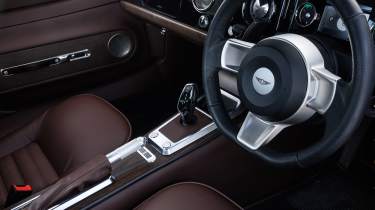
| Pros |
|
| Cons |
|
Morgan knows that much of its cars’ appeal is based on their classically inspired style, and while the Supersport has a few more modern touches than previous Morgans in the name of practicality, it still very much keeps its distinctive look. Some subtle changes such as the new door hinge being relocated to the chassis rather than the wood frame will be music to the ears of those who have experienced ingress of wind through the doors of old Morgans. Elsewhere there are improved panel seals and an overall improvement of quality.
Employing just over 200 people and being a small-scale manufacturer, Morgan naturally falls down compared to industry giants such as Porsche and BMW. Our car was a ‘validation prototype’, so we hope some imperfections will be addressed, but we noticed the odd bit of unsightly sealant around the hard-top’s glass and there was a bit of air creeping on to our elbow from a gap in the driver’s door.
The Plus Six’s charmingly antiquated interior is largely carried over to the Supersport. Ahead of the driver is a relatively tiny (by modern standards) digital display showing the speed, gear selected, driving mode and little else - a conscious design by Morgan to ensure you’re not distracted when driving. This screen is flanked by temperature and fuel gauges, which sit flush against the dash for a cleaner look.
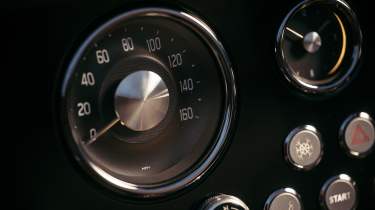
The rev counter and speedometer in the middle of the dash are supplied by Smiths and fit perfectly with the Supersport’s overall aesthetic. Dials for each of the volume and fan speed sit either side of a five-button layout for things such as the air-conditioning, hazards, demister and the starter button. Below the dash you’ll see the cabin two air vents are unchanged from the Plus Six - which is unfortunate, because they don’t provide much cooling power. But the shortage of gadgetry in the cabin does mean you can focus on all the beautiful detailing.
A feature that was a must for Morgan in developing the new Supersport were the removable upper door panels to give a more vintage environment of being exposed to the elements. They’re easier to remove than in the Plus Six, with a one-finger door latch unlocking them - plus you can store them in the boot - which gives you the opportunity to get a glimpse of the Morgan’s beautiful ash frame. The hard-top roof is more of a faff, because while it only weighs 19.7kg, you need two people to lift it off. The concave rear screen also means that rear visibility (just as it is to the front) is wonderful.
There are also some sensational colours to choose from with the Supersport, including various finishes of solid, metallic and three-stage pearl. The lighter metallics looked great to us, really accentuating the curves that are smoother than on the harder-edged Plus Six.
Infotainment, sat-nav and stereo

There’s not much in the way of an infotainment in the Morgan - sticking a huge display inside would not only look out of place, it would also probably alienate every potential customer interested in being whisked off to a world before apps, touchscreens and even the internet.
The Sennheiser Audio system is carried over from the Plus Six, with additional actuators fitted behind the dash and under the seats, and redesigned door speakers. There’s also now wireless calling with Bluetooth connectivity and – get this – active noise cancellation, to make the feature usable with the top down.
“The Supersport’s design shares quite a lot with the Midsummer - which helps differentiates the Supersport from the Plus Six and, just as importantly, the Plus Four. Morgan has been careful to implement just enough handy 21st-century technology without sacrificing the Supersport’s old-school style.” - Alastair Crooks, Senior News Reporter. Tested the Morgan Supersport in Spain.
Boot space & practicality
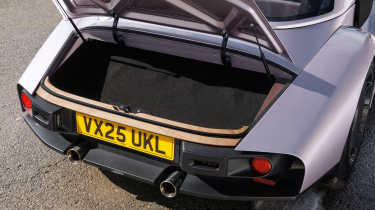
| Pros |
|
| Cons |
|
Morgan recognises that its cars aren’t typically bought to sit on driveways by themselves, but the firm does want the Supersport to be usable throughout the year on more occasions than older models allow. The Supersport doesn’t claim to be the most practical sports car ever made, although Morgan has taken very welcome steps to make it easier to live with. The boot, for instance, isn’t the biggest, but it’ll house a weekend bag and, crucially, the removable upper sections of the doors. The boot can also open automatically via the key. Behind the seats you’ll find some extra storage and there’s a proper glovebox rather than the Plus Six’s mesh net.
Sitting in the Morgan with the roof on, even tall adults well over six feet will be able to get comfortable. The driving position is excellent, although there’s very little in the way of armrests are unless you remove the doors altogether. We found that the cabin had plenty of room for two adults, despite that narrow centre console.
| Dimensions | |
| Length | 4,110mm |
| Width | 1,805mm |
| Height | 1,290mm |
| Number of seats | Two |
| Boot space | N/A |
“If practicality is a key consideration when you’re shopping for your next sports car, then the Supersport might not be ideal. However, there have been steps taken off the back of customer feedback, such as the phone holder and boot storage, which will go down well with traditional Morgan fans.” - Alastair Crooks, Senior News Reporter. Tested the Morgan Supersport in Spain.
Morgan Supersport pictures
Frequently Asked Questions
The Morgan Supersport starts from £102,000 with the soft-top costing an extra £2,000 and the hard-top £3,000.

